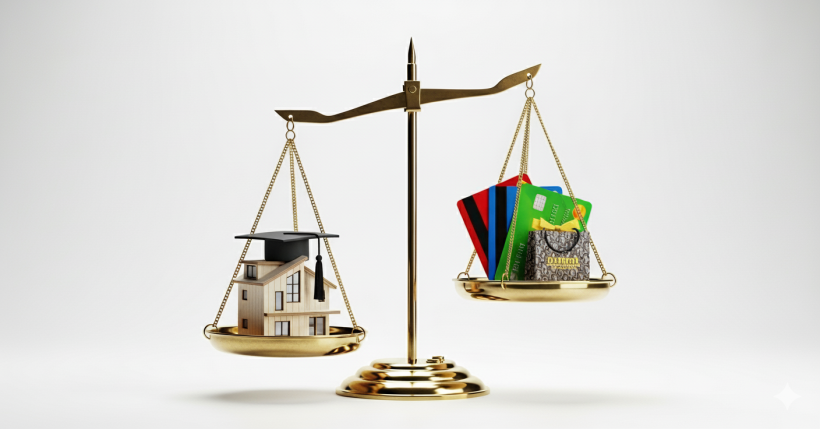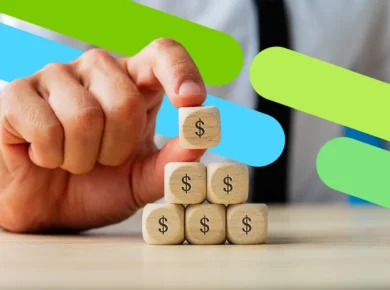If you’re just starting your career, the word “debt” probably sounds like a four-letter word. We’re often taught that borrowing money is bad and should be avoided at all costs.
While that’s good advice for avoiding financial trouble, it’s not the whole story.In the world of personal finance, not all debt is created equal. In fact, some types of debt can be powerful tools to help you build wealth and achieve your biggest goals, while others can quickly become a financial trap. Understanding the difference between “good debt” and “bad debt” is one of the most important lessons for anyone new to managing their money. Let’s break it down.
What Makes Debt “Good”? 🤔
Think of good debt as an investment in yourself and your future. It’s money you borrow to purchase something that will increase in value or boost your long-term earning potential. Essentially, you’re using borrowed funds to acquire an asset that will eventually make you more money or increase your net worth. It’s a strategic move, not just a purchase.
Here are the classic examples of good debt:
- Mortgages: Taking out a loan to buy a home is probably the best-known example. While it’s a huge debt, you’re acquiring a physical asset that, historically, appreciates in value over time. Instead of paying rent to a landlord, your payments are building equity in something you own.
- Student Loans: Borrowing money for education can directly increase your earning power over your lifetime. A college degree or specialized certification can open doors to higher-paying jobs, making the debt a worthwhile investment in your career.
- Business Loans: If you have an entrepreneurial spirit, taking out a loan to start or expand a business can help you generate income and build a valuable company. The goal is for the business’s profits to far outweigh the cost of the loan.
What Makes Debt “Bad”? 🛍️
Bad debt is the opposite. It’s money you borrow to pay for things that lose value over time or are consumed immediately. It’s often tied to instant gratification and typically comes with high interest rates, making the items you buy far more expensive in the long run. Bad debt subtracts from your net worth and can quickly spiral out of control if not managed carefully.
Common types of bad debt include:
- Credit Card Debt: This is the most common form of bad debt. Swiping a credit card for clothes, dinners, gadgets, or vacations that you can’t pay off immediately means you’ll be hit with high interest rates (often 20% or more). That $50 dinner can end up costing you much more over time.
- Payday Loans: These are extremely high-interest, short-term loans designed to be paid back on your next payday. They are a dangerous trap that can lead to a devastating cycle of borrowing. Avoid them at all costs.
- High-Interest Auto Loans: This can be a gray area. A loan for a reliable car to get you to work is often a necessity. However, borrowing a large sum for a fancy, expensive car that will depreciate the second you drive it off the lot is a classic example of bad debt.
How to Ask the Right Questions Before Borrowing
The line between good and bad isn’t always black and white. Even “good” debt can turn bad if you borrow more than you can afford. The key is to be intentional and ask yourself the right questions before signing any loan agreement. Understanding how setting financial goals can guide these decisions is crucial. A loan should always align with your long-term plan.
Before you take on new debt, ask yourself:
- Will this increase my net worth or income? Is it an investment in an asset (like a house) or my skills (like education), or is it for something that will be gone or worthless soon?
- Can I comfortably afford the monthly payment? Look at your budget honestly. Will this payment strain your finances and prevent you from saving or handling emergencies?
- What is the interest rate? A low-interest mortgage is fundamentally different from a high-interest credit card. The interest rate determines the true cost of borrowing.
- How will this affect my financial health? Every loan you take on and how you manage the payments impacts your credit score. Be sure you are ready for that responsibility.
Use Debt as a Tool, Not a Crutch
Ultimately, debt is a financial tool. Used wisely, it can help you build the life you want faster than you could with cash alone. Used carelessly, it can weigh you down for years. As you navigate your personal finance journey, learning to distinguish between debt that lifts you up and debt that holds you back is a critical skill. By making conscious, informed decisions, you can take control of your borrowing and build a secure financial future.
Disclaimer: This article is for informational purposes only and does not constitute financial or legal advice. Consult with a qualified professional before making any financial decisions.






